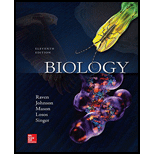
Concept explainers
The experiments with nutritional mutants in Neurospora by Beadle and Tatum provided evidence that
a. bread mold can be grown in a lab on minimal media.
b. X-rays can damage DNA.
c. cells need enzymes.
d. genes specify enzymes.
Introduction:
To identify the working nature of genes, scientists from all over the world conducted various experiments. The results revealed by them include, the functions controlled by the genes and the enzymes specified by the genes.
Answer to Problem 1U
Correct answer:
The experiments with nutritional mutants in Neurospora by Beadle and Tatum provided evidence that genes specify enzymes. Therefore, option d. is correct.
Explanation of Solution
Reason for the correct statement:
Beadle and Tatum showed that genes specify enzymes. In neurospora, each enzyme of the arginine pathway was encoded by a separate gene. The mutant species of neurospora were unable to synthesize arginine. Beadle and Tatum found that specific enzymes controlled by specific genes were absent in the mutant neurospora. They proposed the one gene-one enzyme hypothesis.
Option d. is given as "genes specify enzymes".
As, “the experiments with nutritional mutants in Neurospora by Beadle and Tatum provided evidence that genes specify enzymes”, it is the right answer.
Hence, the option d. is correct.
Reasons for the incorrect statements:
Option a. is given as “bread mold can be grown in a lab on minimal media”.
In the experiments conducted by Beadle and Tatum, bread mold was grown to determine the enzymes specific for the growth. So, it is a wrong answer.
Option b. is given as “X-rays can damage DNA”.
The experiments conducted by Beadle and Tatum to determine the limiting factors for specific enzymes and not to determine what X-rays do to the DNA. So, it is a wrong answer.
Option c. is given as “cells need enzymes”.
The experiments conducted by Beadle and Tatum were performed to determine the limiting factors, which control synthesis of enzymes responsible for specific functions. So, it is a wrong answer.
Hence, the options a., b., and c. are incorrect.
The experiments with nutritional mutants in Neurospora by Beadle and Tatum provided evidence that genes specify enzymes.
Want to see more full solutions like this?
Chapter 15 Solutions
Biology
- Species Interactions Explain how predators, prey and scavengers interact. Explain whether predators and scavengers are necessary or beneficial for an ecosystem.arrow_forwardmagine that you are conducting research on fruit type and seed dispersal. You submitted a paper to a peer-reviewed journal that addresses the factors that impact fruit type and seed dispersal mechanisms in plants of Central America. The editor of the journal communicates that your paper may be published if you make ‘minor revisions’ to the document. Describe two characteristics that you would expect in seeds that are dispersed by the wind. Contrast this with what you would expect for seeds that are gathered, buried or eaten by animals, and explain why they are different. (Editor’s note: Providing this information in your discussion will help readers to consider the significance of the research).arrow_forwardWhat is the difference between Uniporters, Symporters and Antiporters? Which of these are examples of active transport?arrow_forward
- What are Amyloid Fibrils? What biological functions are these known to perform?arrow_forwardHow do histamine and prostaglandins help in the mobilization of leukocytes to an injury site? What are chemotactic factors? How do they affect inflammation process?arrow_forwardCompare and contrast neutrophils and macrophages. Describe two ways they are different and two ways they are similar.arrow_forward
- Describe the effects of three cytokines (not involved in the initial inflammation response). What cells release them?arrow_forwardDescribe activation of helper T cells or cytotoxic T cellsarrow_forwardCompare and contrast MHC 1 and MHC 2. Describe two way they are different and two ways they similar including how they are used in antigen presentation.arrow_forward
 Human Anatomy & Physiology (11th Edition)BiologyISBN:9780134580999Author:Elaine N. Marieb, Katja N. HoehnPublisher:PEARSON
Human Anatomy & Physiology (11th Edition)BiologyISBN:9780134580999Author:Elaine N. Marieb, Katja N. HoehnPublisher:PEARSON Biology 2eBiologyISBN:9781947172517Author:Matthew Douglas, Jung Choi, Mary Ann ClarkPublisher:OpenStax
Biology 2eBiologyISBN:9781947172517Author:Matthew Douglas, Jung Choi, Mary Ann ClarkPublisher:OpenStax Anatomy & PhysiologyBiologyISBN:9781259398629Author:McKinley, Michael P., O'loughlin, Valerie Dean, Bidle, Theresa StouterPublisher:Mcgraw Hill Education,
Anatomy & PhysiologyBiologyISBN:9781259398629Author:McKinley, Michael P., O'loughlin, Valerie Dean, Bidle, Theresa StouterPublisher:Mcgraw Hill Education, Molecular Biology of the Cell (Sixth Edition)BiologyISBN:9780815344322Author:Bruce Alberts, Alexander D. Johnson, Julian Lewis, David Morgan, Martin Raff, Keith Roberts, Peter WalterPublisher:W. W. Norton & Company
Molecular Biology of the Cell (Sixth Edition)BiologyISBN:9780815344322Author:Bruce Alberts, Alexander D. Johnson, Julian Lewis, David Morgan, Martin Raff, Keith Roberts, Peter WalterPublisher:W. W. Norton & Company Laboratory Manual For Human Anatomy & PhysiologyBiologyISBN:9781260159363Author:Martin, Terry R., Prentice-craver, CynthiaPublisher:McGraw-Hill Publishing Co.
Laboratory Manual For Human Anatomy & PhysiologyBiologyISBN:9781260159363Author:Martin, Terry R., Prentice-craver, CynthiaPublisher:McGraw-Hill Publishing Co. Inquiry Into Life (16th Edition)BiologyISBN:9781260231700Author:Sylvia S. Mader, Michael WindelspechtPublisher:McGraw Hill Education
Inquiry Into Life (16th Edition)BiologyISBN:9781260231700Author:Sylvia S. Mader, Michael WindelspechtPublisher:McGraw Hill Education





